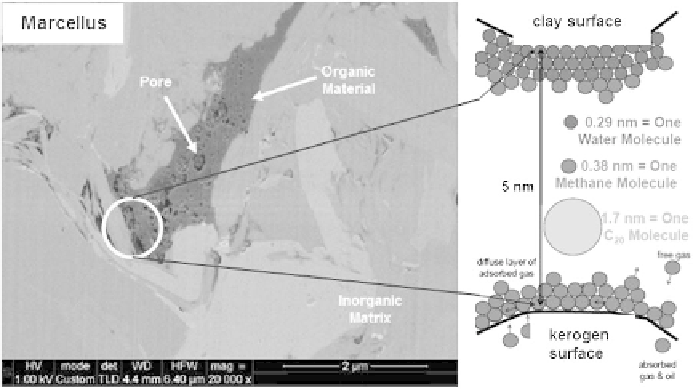Environmental Engineering Reference
In-Depth Information
Figure 10 Marcellus Shale Formation SEM image showing organic porosity devel-
opment and pore schematic illustrating free versus adsorbed gas storage.
of the predominantly organic-matter pores and, to a much lesser extent, clay
mineral surfaces, while non-adsorbed methane molecules occupy the por-
osity as free gas. Recent work has shown that the organic matter content of
resource shales play a critical role in both hydrocarbon generation and
storage, particularly of gas, with experimental data from US lower Palaeo-
zoic-aged shales showing a strong correlation between organic content
(TOC) and both microporosity and sorbed methane content.
38
Sorption experiments have shown that more methane is sorbed by organic
matter than by the host shale, with a greater uptake at higher gas-window
maturities.
39
Experiments on Jurassic-aged Posidonia shales show that me-
thane sorption occurs predominantly in pores of 5 nm or less diameter,
which form between 35 and 90% of the total porosity, and is distributed
equally within both the clay mineral matrix and the organic matter.
39
Me-
thane sorption was found to be dependent on organic content (TOC) (see
Figure 11) and varies between shales (see Figure 12), decreasing with tem-
perature and increasing with pressure, reaching an equilibrium at pressures
of around 10 MPa. Sorption capacity in organic rich shales is dependent on
thermal maturity and is reduced by the presence of moisture due to com-
petitive adsorption between water and methane molecules.
39,40
3.5 Mineralogy
Shales with high quartz, carbonate and feldspar contents have a high
brittleness and a low Poisson's Ratio and high Young's Modulus, generally
exhibiting a good relationship with both natural or artificial fracture devel-
opment.
41
Successful gas-shales tend to have both a high organic matter
content and a ''brittle'' mineral matrix, indicating that both the generation

